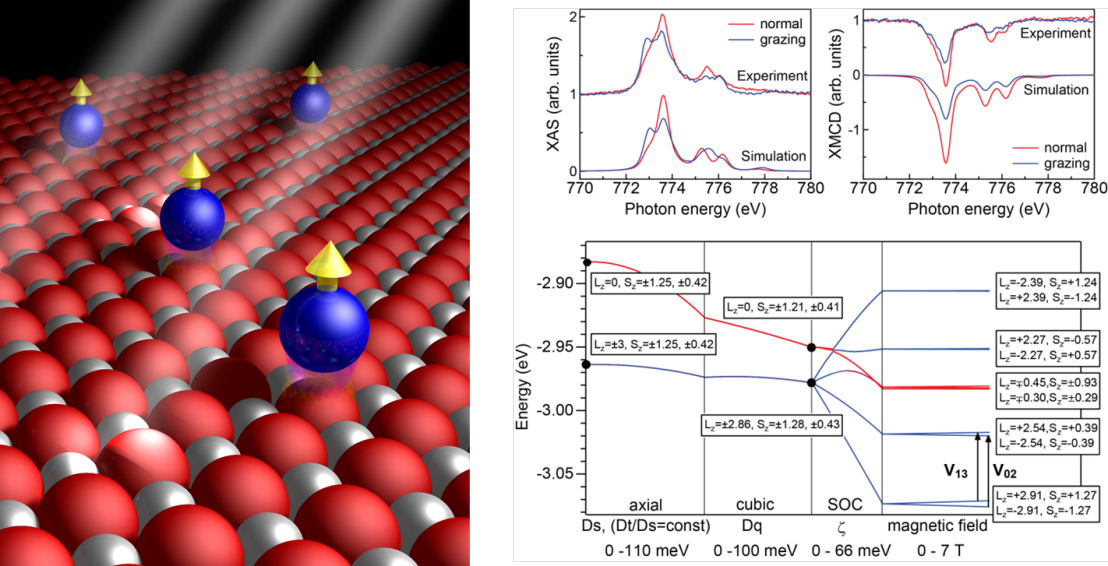Maximizing the magnetic anisotropy of transition-metal atoms

In this work we describe a spin system that achieves the maximum amount of magnetic anisotropy for a transition metal atom. This is a long-sought goal that has been pursued in magnetic nanostructures and single molecule magnets, which we finally realize for single Co atoms axially coordinated to an MgO substrate.
Reaching maximum magnetic anisotropy is key to achieving stability in nanoscale magnets. As the dimensions of a magnetic material shrink below a few nanometers, thermal fluctuations and external perturbations disrupt magnetic alignment. To keep the magnetization stable, the magnetic “hardness” of a material should be increased on a per atom basis. This can be achieved by providing a strongly anisotropic environment for the magnetic atoms using axial ligands, which induce a strong preference for the magnetic moment to align along one direction and large energy barriers for magnetization reversal. This strategy, known for molecular magnets, was applied here to single Co atoms on a solid state substrate. We find a record magnetic anisotropy energy (zero field splitting) of the order of 60 meV/atom, a spin lifetime of 200 μs at cryogenic temperature, and identify the rate-limiting spin relaxation factors.
Our study is based on time-resolved inelastic tunneling spectroscopy carried out by STM as well as polarized x-ray absorption spectroscopy measurements. This is the first time that these two approaches are combined in a consistent way thanks to an extensive collaboration between different groups at ETHZ, IBM Almaden, and EPFL. The results, despite the very different energy scales probed by STM and x-rays, coincide to a remarkable degree of accuracy. Multiplet and density functional calculations beautifully model our observations.
Interestingly, this system also represents the ultimate downscaling limit of magnetic tunnel junction (MTJ) devices based on perpendicularly magnetized Co,Fe/MgO layers. The size of the most advanced spintronic devices today, based on CoFeB/MgO tunnel junctions, is just above 20 nm. This work gives a glimpse into the future, when size reduction will bring about quantum effects that may be detrimental for classical computing but significant for quantum computing devices.
Read more about it in the ETH news.
Selected Publications
- Origin of perpendicular magnetic anisotropy and large orbital moment in Fe atoms on MgO, S. Baumann, F. Donati, S. Stepanow, S. Rusponi, W. Paul, S. Gangopadhyay, I. G. Rau, G. E. Pacchioni, L. Gragnaniello, M. Pivetta, J. Dreiser, C. Piamonteze, C. P. Lutz, R. M. Macfarlane, B. A. Jones, P. Gambardella, A. J. Heinrich, and H. Brune, Phys. Rev. Lett. 115, 237202 (2015). Download article (PDF, 580 KB) Download supplementary information (PDF, 880 KB)
- Reaching the magnetic anisotropy limit of a 3d metal atom, I. G. Rau, S. Baumann, S. Rusponi, F. Donati, S. Stepanow, L. Gragnaniello, J. Dreiser, C. Piamonteze, F. Nolting, S. Gangopadhyay, O. R. Albertini, R. M. Macfarlane, C. P. Lutz, B. Jones, P. Gambardella, A. J. Heinrich and H. Brune, Science 344, 988 (2014). Download article (PDF, 3.3 MB)
- Magnetism of individual atoms adsorbed on surfaces, H. Brune and P. Gambardella, Surf. Sci. 603, 1830 (2009). Download article (PDF, 1.3 MB)
- Giant magnetic anisotropy of single Co atoms and nanoparticles, P. Gambardella, S. Rusponi, M. Veronese, S.S. Dhesi, I. Cabria, R. Zeller, P.H. Dederichs, A. Dallmeyer, C. Grazioli, K. Kern, C. Carbone, and H. Brune, Science 300, 1130 (2003). Download article (PDF, 286 KB)